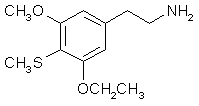
#164 4-TME
4-THIOMETAESCALINE; 3-ETHOXY-5-METHOXY-4-METHYLTHIOPHENETHYLAMINE
|
| [3D .mol structure] |
To a stirred solution of 7.6 g of 3-ethoxy-2-(methylthio)anisole in 100 mL CH2Cl2 there was added 6.2 g elemental bromine dissolved in 50 mL CH2Cl2. The initial dark red color gradually faded to a pale yellow and there was a steady evolution of HBr. An added crystal of iodine did not appear to increase the rate of reaction. After 4 min the color was a pale orange. The reaction mixture was extracted with H2O containing sufficient dithionite to remove most of the residual color. The solvent was removed under vacuum leaving 12.2 g of a pale yellow fluid oil. This was distilled at 100-110 °C at 0.3 mm/Hg to yield a mixture of 4-bromo-3-ethoxy-2-(methylthio)anisole and 6-bromo-3-ethoxy-2-(methylthio)anisole as a pale yellow, highly refractory oil that was used as such in the following reaction. Anal. (C10H13BrO2S) C,H.
To a solution of 12 mL diisopropylamine in 75 mL anhydrous THF that was stirred under an N2 atmosphere and cooled to -10 °C with an external ice/MeOH bath, there was added in sequence 35 mL of 1.6 M butyllithium in hexane, 1.8 mL of dry acetonitrile, and 5.0 g of 4-bromo- (and 6-bromo)-3-ethoxy-2-(methylthio)anisole. The reaction mixture changed color from yellow to red to reddish brown. Stirring was maintained for an additional 0.5 h, and then the reaction mixture was poured into 80 mL of dilute H2SO4. The phases were separated, and the aqueous phase was extracted with 100 mL CH2Cl2. The organic phases were combined, and the solvent was removed under vacuum. The oily residue was distilled at 0.2 mm/Hg yielded two fractions. The first fraction boiled at 90-115 °C and weighed 1.7 g. This material proved to be largely the unreacted bromo starting materials. The second fraction came over at 140- 170 °C, weighed 1.7 g, and it crystallized when seeded with a small crystal obtained externally with dry ice. This fraction was recrystallized from 10 mL MeOH, filtered, and washed sparingly with cold MeOH. After air drying, there was obtained 0.5 g 3-ethoxy-5-methoxy-4-methylthiophenylacetonitrile which had a mp of 65-66 °C. Anal. (C12H15NO2S) C,H.
A suspension of 0.5 g LAH in 50 mL anhydrous THF under N2 was cooled to 0 °C and vigorously stirred. There was added, dropwise, 0.35 mL 100% H2SO4, followed by 0.45 g 3-ethoxy-5-methoxy-4-methylthiophenylacetonitrile in 10 mL anhydrous THF. The reaction mixture was stirred at 0 °C for a few min, then brought to a reflux for a few min on the steam bath. After allowing the mixture to return to room temperature, there was added IPA sufficient to destroy the excess hydride followed by 10% NaOH to bring the reaction to a basic pH and to convert the aluminum oxide to a loose, white, filterable consistency. This was removed by filtration, and washed with 50 mL IPA. The filtrate and washes were stripped of solvent in vacuo, and the residue suspended in dilute H2SO4. This was washed with 2x75 mL CH2Cl2, made basic with aqueous NaOH, and the product extracted with 2x75 mL CH2Cl2. After combining these extracts, the solvent was removed under vacuum providing 1.2 g of a residue which was distilled at 132-140 °C at 0.4 mm/Hg to give 0.35 g of a colorless oil. This was dissolved in 7 mL of IPA, neutralized with 7 drops of concentrated HCl and diluted with 3 volumes of anhydrous Et2O. The product was removed by filtration, washed with Et2O, and air dried to give 0.30 g 3-ethoxy-5-methoxy-4-methylthiophenethylamine hydrochloride (4-TME) as white crystals with a mp of 164-165 °C. Anal. (C12H20ClNO2S) C,H.
DOSAGE: 60 - 100 mg.
DURATION: 10 - 15 h.
QUALITATIVE COMMENTS: (with 60 mg) There was a strange off-baseness for several hours in the middle of the day, which was replaced by a mild gastric upset in the evening. The mild mental disturbance is neither visual nor particularly interesting.
(with 100 mg) A benign and gentle altered state became progressively sad and morbid. Nothing went together well--I could not empathize with anyone, and trying to write at the typewriter was useless. So were efforts to sleep at midnight, but this was totally relieved with 200 milligrams of Miltown. In the morning I seemed still to be off baseline, and I was extremely sleepy, with much lethargy. Even several days later there were problems trying to integrate my emotions and feelings. I am not yet completely at peace.
EXTENSIONS AND COMMENTARY: Sometimes things work well in their mysterious ways. The reports with 4-TME were more to the toxic than to the joyous side, and this by chance with a compound that could only be obtained in an atrociously small yield.
| [ |
[Main Index] | [Forward |

